A New Method for Determining Interfacial Tension: Verification and Validation
Abstract
:1. Introduction
- γ—surface tension [N/m],
- Rb—the radius of the bubble [m],
- vv—specific volume of the vapor [m3/kg],
- vs—specific volume of the saturated liquid [m3/kg],
- ΔHvap—enthalpy of vaporization [J/kg],
- Bv—specific gas constant for vapor [J/(kg·K)],
- ps—absolute pressure of the saturated liquid [N/m2].
- dh—hydraulic diameter of a channel [m]
- g—gravitational acceleration [m/s];
- ρl—density of a liquid [kg/m3];
- ρv—density of a vapor [kg/m3].
- Δp—pressure difference between two sides of the interface in the bulk phases [Pa];
- R1, R2—the main radii of curvature [m].
Non-Equilibrium Model for Axisymmetric Drop or Bubble
- pdl—pressure in the interior, which is filled with denser liquid [Pa];
- plf—pressure in the exterior, where there is a lighter fluid [Pa],
- Δp—pressure difference between two sides of the interface [Pa],
- ρdl—density of a denser liquid [kg/m3];
- ρlf—density of a lighter fluid [kg/m3].
2. Materials and Methods
- Δl-sU0—internal energy change from the liquid phase to the surface at the reference temperature [J];
- NA—Avogadro number [-];
- T—temperature [°C];
- tc—critical temperature [°C];
- νl—molar volume of liquid phase [m3];
- νv—molar volume of vapor phase [m3];
- l—a correction factor [m].
3. Results and Discussion
Author Contributions
Funding
Data Availability Statement
Conflicts of Interest
References
- Rymkiewicz, J.; Zapalowicz, Z. Analysis of the evaporation process for water droplet on flat heated surface. Int. Commun. Heat Mass Transf. 1993, 20, 687–697. [Google Scholar] [CrossRef]
- Wiśniewski, S. Wymiana Ciepła, 1st ed.; Państwowe Wydawnictwo Naukowe: Warszawa, Poland, 1979; ISBN 83-01-00754-0. [Google Scholar]
- Gil, B.; Rogala, Z.; Dorosz, P. Pool Boiling Heat Transfer Coefficient of Low-Pressure Glow Plasma Treated Water at Atmospheric and Reduced Pressure. Energies 2020, 13, 69. [Google Scholar] [CrossRef] [Green Version]
- Estellé, P.; Cabaleiro, D.; Żyła, G.; Lugo, L.; Murshed, S.M.S. Current trends in surface tension and wetting behavior of nanofluids. Renew. Sustain. Energy Rev. 2018, 94, 931–944. [Google Scholar] [CrossRef]
- Huang, M.; Borzoei, H.; Abdollahi, A.; Li, Z.; Karimipour, A. Effect of concentration and sedimentation on boiling heat transfer coefficient of GNPs-SiO2/deionized water hybrid Nanofluid: An experimental investigation. Int. Commun. Heat Mass Transf. 2021, 122, 105141. [Google Scholar] [CrossRef]
- Kujawska, A.; Mulka, R.; Hamze, S.; Żyła, G.; Zajaczkowski, B.; Buschmann, M.H.; Estellé, P. The effect of boiling in a thermosyphon on surface tension and contact angle of silica and graphene oxide nanofluids. Colloids Surfaces A Physicochem. Eng. Asp. 2021, 627, 127082. [Google Scholar] [CrossRef]
- Acharya, A.; Pise, A. A review on augmentation of heat transfer in boiling using surfactants/additives. Heat Mass Transf. 2017, 53, 1457–1477. [Google Scholar] [CrossRef]
- Cornwell, K.; Kew, P.A. Boiling in Small Parallel Channels BT—Energy Efficiency in Process Technology; Pilavachi, P.A., Ed.; Springer: Dordrecht, The Netherlands, 1993; pp. 624–638. ISBN 978-94-011-1454-7. [Google Scholar]
- Kew, P.A.; Cornwell, K. Correlations for the prediction of boiling heat transfer in small-diameter channels. Appl. Therm. Eng. 1997, 17, 705–715. [Google Scholar] [CrossRef]
- Mikielewicz, J. Semi-empirical method of determining the heat-transfer coefficient for subcooled, saturated boiling in a channel. Int. J. Heat Mass Transf. 1974, 17, 1129–1134. [Google Scholar] [CrossRef]
- Mikielewicz, D.; Mikielewicz, J.; Tesmar, J. Improved semi-empirical method for determination of heat transfer coefficient in flow boiling in conventional and small diameter tubes. Int. J. Heat Mass Transf. 2007, 50, 3949–3956. [Google Scholar] [CrossRef]
- Pastuszko, R.; Kaniowski, R.; Dadas, N.; Bedla-Pawlusek, M. Pool boiling enhancement and a method of bubble diameter determination on surfaces with deep minichannels. Int. J. Heat Mass Transf. 2021, 179, 121713. [Google Scholar] [CrossRef]
- Zapałowicz, Z.; Zeńczak, W. The possibilities to improve ship’s energy efficiency through the application of PV installation including cooled modules. Renew. Sustain. Energy Rev. 2021, 143, 110964. [Google Scholar] [CrossRef]
- Zapałowicz, Z.; Opiela, A. Boundary value of the air distribution coefficient that ensures working effectivity of the air-condition system connected with ground heat exchanger and with PV installation. Sustain. Cities Soc. 2018, 42, 93–99. [Google Scholar] [CrossRef]
- Kapusta, Ł.J.; Bachanek, J.; Jiang, C.; Piaszyk, J.; Xu, H.; Wyszyński, M.L. Liquid Propane Injection in Flash-Boiling Conditions. Energies 2021, 14, 6257. [Google Scholar] [CrossRef]
- Bizon, K.; Continillo, G.; Lombardi, S.; Sementa, P.; Vaglieco, B.M. Independent component analysis of cycle resolved combustion images from a spark ignition optical engine. Combust. Flame 2016, 163, 258–269. [Google Scholar] [CrossRef]
- Wiącek, A.E.; Przykaza, K. Wettability and Stability of Naproxen, Ibuprofen and/or Cyclosporine A/Silica Delivery Systems. Colloids Interfaces 2022, 6, 11. [Google Scholar] [CrossRef]
- Dopierała, K.; Karwowska, K.; Petelska, A.D.; Prochaska, K. Thermodynamic, viscoelastic and electrical properties of lipid membranes in the presence of astaxanthin. Biophys. Chem. 2020, 258, 106318. [Google Scholar] [CrossRef] [PubMed]
- Korczeniewski, E.; Bryk, P.; Koter, S.; Kowalczyk, P.; Zięba, M.; Łępicka, M.; Kurzydłowski, K.J.; Markiewicz, K.H.; Wilczewska, A.Z.; Kujawski, W.; et al. Are nanohedgehogs thirsty? Toward new superhydrophobic and anti-icing carbon nanohorn-polymer hybrid surfaces. Chem. Eng. J. 2022, 446, 137126. [Google Scholar] [CrossRef]
- Hossain, F.M.; Nurun Nabi, M.; Mostafizur Rahman, M.; Bari, S.; Van, T.C.; Ashrafur Rahman, S.M.; Rainey, T.J.; Bodisco, T.A.; Suara, K.; Ristovski, Z.; et al. Experimental investigation of diesel engine performance, combustion and emissions using a novel series of dioctyl phthalate (DOP) biofuels derived from microalgae. Energies 2019, 12, 1964. [Google Scholar] [CrossRef] [Green Version]
- Young, T. An essay on the cohesion of fluids. Philos. Trans. R. Soc. London 1805, 95, 65–87. [Google Scholar] [CrossRef]
- Adamson, A.W. Fizičeskaja Chimija Poverchnostej; “Mir”: Moskva, Russia, 1979. [Google Scholar]
- Gibbs, J.W. The Scientific Papers of J. Willard Gibbs: In Two Volumes. Vol. 1, Thermodynamics; Dover Publications, Inc.: New York, NY, USA, 1961. [Google Scholar]
- Bashforth, F.; Adams, J.C. On the calculation of the theoretical forms of drops of fluid, under the influence of capillary action, when such drops are bounded by surfaces of revolution which meet their respective axes at right angles. In An Attempt to Test the Theories of Capillary Action by Comparing the Theoretical and Measured Forms of Drops of Fluid; Cambridge University Press: Cambridge, UK, 1883; pp. 13–54. [Google Scholar]
- Hartland, S.; Hartley, R.W. Axisymmetric Fluid-Liquid Interfaces; Elsevier Scientific Publishing Company: Amsterdam, The Netherland, 1976; ISBN 0-444-41396-0. [Google Scholar]
- Rotenberg, Y.; Boruvka, L.; Neumann, A.W. Determination of surface tension and contact angle from the shapes of axisymmetric fluid interfaces. J. Colloid Interface Sci. 1983, 93, 169–183. [Google Scholar] [CrossRef]
- Cheng, P.; Li, D.; Boruvka, L.; Rotenberg, Y.; Neumann, A.W. Automation of axisymmetric drop shape analysis for measurements of interfacial tensions and contact angles. Colloids Surfaces 1990, 43, 151–167. [Google Scholar] [CrossRef]
- Kwok, D.Y.; Wu, R.; Alvarez, J.M.; Neumann, A.W. Contact angle measurements by axisymmetric drop shape analysis and an automated polynomial fit program. Colloids Surf. A Physicochem. Eng. Asp. 1998, 143, 197–210. [Google Scholar]
- Li, J.; Miller, R.; Möhwald, H. Phospholipid monolayers and their dynamic interfacial behaviour studied by axisymmetric drop shape analysis. Thin Solid Films 1996, 284–285, 357–360. [Google Scholar] [CrossRef]
- Pasandideh-Fard, M.; Chen, P.; Mostaghimi, J.; Neumann, A.W. The generalized Laplace equation of capillarity I. Thermodynamic and hydrostatic considerations of the fundamental equation for interfaces. Adv. Colloid Interface Sci. 1996, 63, 151–177. [Google Scholar] [CrossRef]
- Del Río, O.I.; Neumann, A.W. Axisymmetric drop shape analysis: Computational methods for the measurement of interfacial properties from the shape and dimensions of pendant and sessile drops. J. Colloid Interface Sci. 1997, 196, 136–147. [Google Scholar] [CrossRef] [Green Version]
- Jůza, J. The pendant drop method of surface tension measurement: Equation interpolating the shape factor tables for several selected planes. Czechoslov. J. Phys. 1997, 47, 351–357. [Google Scholar] [CrossRef]
- Kazayawoko, M.; Neumann, A.W.; Balatinecz, J.J. Estimating the wettability of wood by the Axisymmetric Drop Shape Analysis-contact Diameter method. Wood Sci. Technol. 1997, 31, 87–95. [Google Scholar] [CrossRef]
- Kwok, D.Y.; Cheung, L.K.; Park, C.B.; Neumann, A.W. Study on the surface tensions of polymer melts using axisymmetric drop shape analysis. Polym. Eng. Sci. 1998, 38, 757–764. [Google Scholar] [CrossRef]
- Berry, J.D.; Neeson, M.J.; Dagastine, R.R.; Chan, D.Y.C.; Tabor, R.F. Measurement of surface and interfacial tension using pendant drop tensiometry. J. Colloid Interface Sci. 2015, 454, 226–237. [Google Scholar] [CrossRef]
- Hoorfar, M.; Neumann, A.W. Recent progress in Axisymmetric Drop Shape Analysis (ADSA). Adv. Colloid Interface Sci. 2006, 121, 25–49. [Google Scholar] [CrossRef]
- Saad, S.M.I.; Neumann, A.W. Axisymmetric Drop Shape Analysis (ADSA): An Outline. Adv. Colloid Interface Sci. 2016, 238, 62–87. [Google Scholar] [CrossRef] [PubMed]
- Gajewski, A. A couple new ways of surface tension determination. Int. J. Heat Mass Transf. 2017, 115, 909–917. [Google Scholar] [CrossRef]
- Gajewski, A. Liquid-gas interface under hydrostatic pressure. In WIT Transactions on Engineering Sciences; WIT Press: Split, Croatia, 2012; Volume 74. [Google Scholar]
- Gajewski, A. Efekty Napięcia Powierzchniowego w Strugach i Kroplach; Oficyna Wydawnicza Politechniki Białostockiej: Białystok, Poland, 2016; ISBN 978-83-65596-03-1. [Google Scholar]
- Mezger, E. Loi de variation de la tension superficielle avec la température. J. Phys. Radium 1946, 7, 303–309. [Google Scholar] [CrossRef]
- Teleszewski, T.J.; Gajewski, A. The Latest Method for Surface Tension Determination: Experimental Validation. Energies 2020, 13, 3629. [Google Scholar] [CrossRef]
- Harkins, W.D.; Brown, F.E. Determination of surface tension (free surface energy) and the weight of falling drops: The surface tension of water and benzene by the capillary height method. J. Am. Chem. Soc. 1919, 41, 499–524. [Google Scholar] [CrossRef]
- Zeppieri, S.; Rodríguez, J.; López De Ramos, A.L. Interfacial tension of alkane + water systems. J. Chem. Eng. Data 2001, 46, 1086–1088. [Google Scholar] [CrossRef]
- Washburn, E.W.; West, C.J.; Dorsey, N.E.; Bichowsky, F.R.; Klemenc, A. (Eds.) The Properties of Surfaces: Surface Tension, Surface Energy and Related Properties. In International Critical Tables of Numerical Data, Physics, Chemistry and Technology; Knovel: Norwich, NY, USA, 2003; pp. 432–446. [Google Scholar]
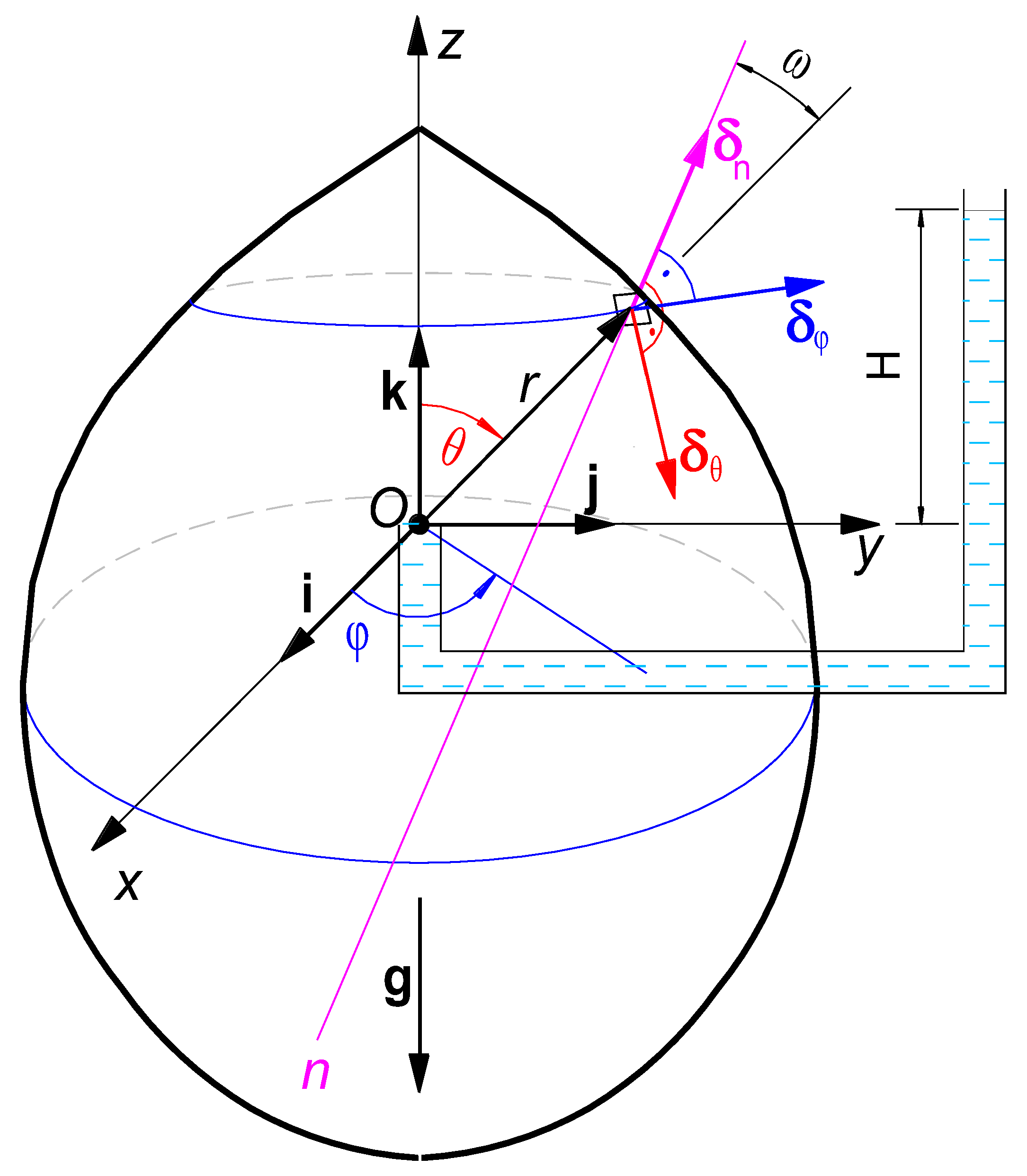
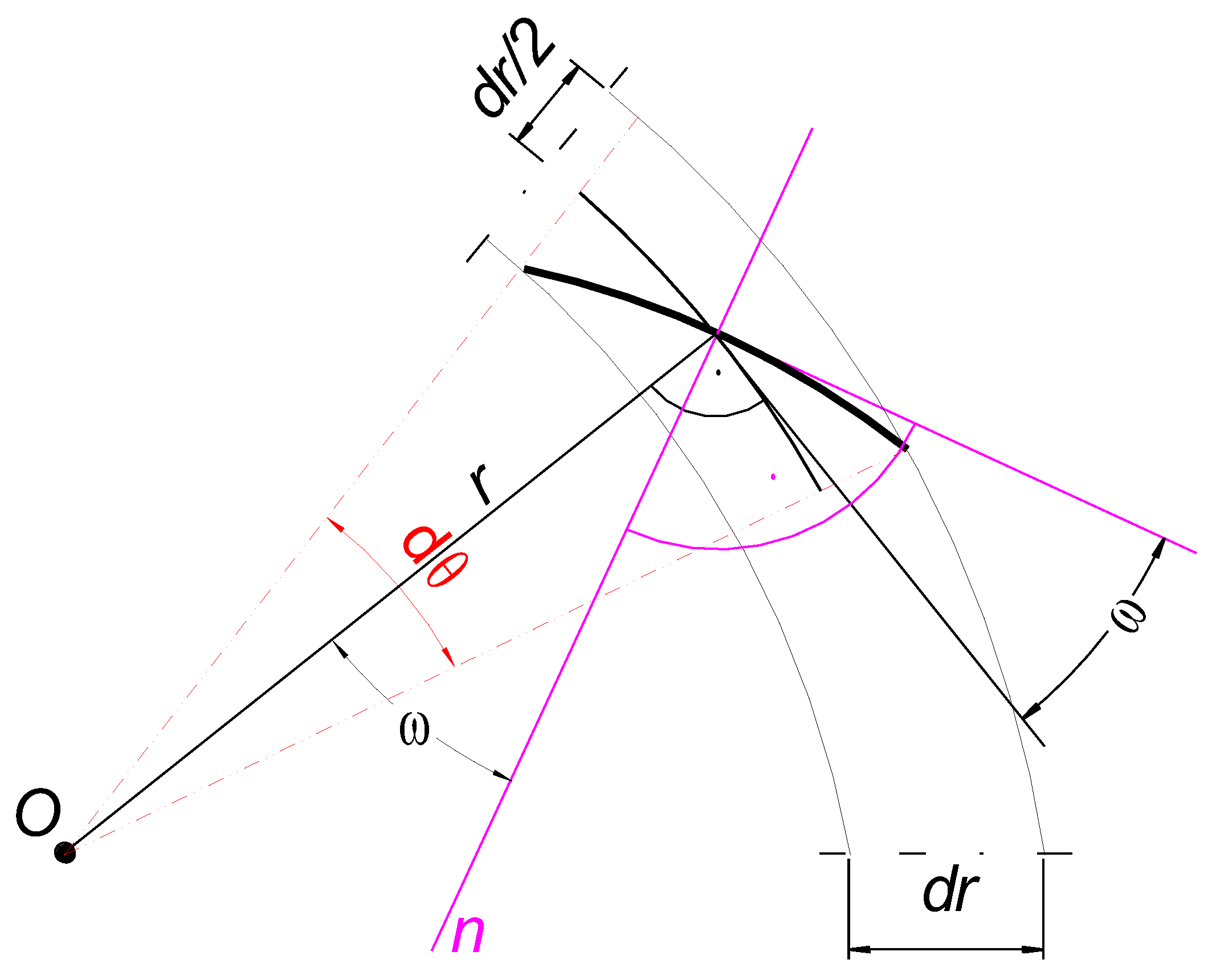
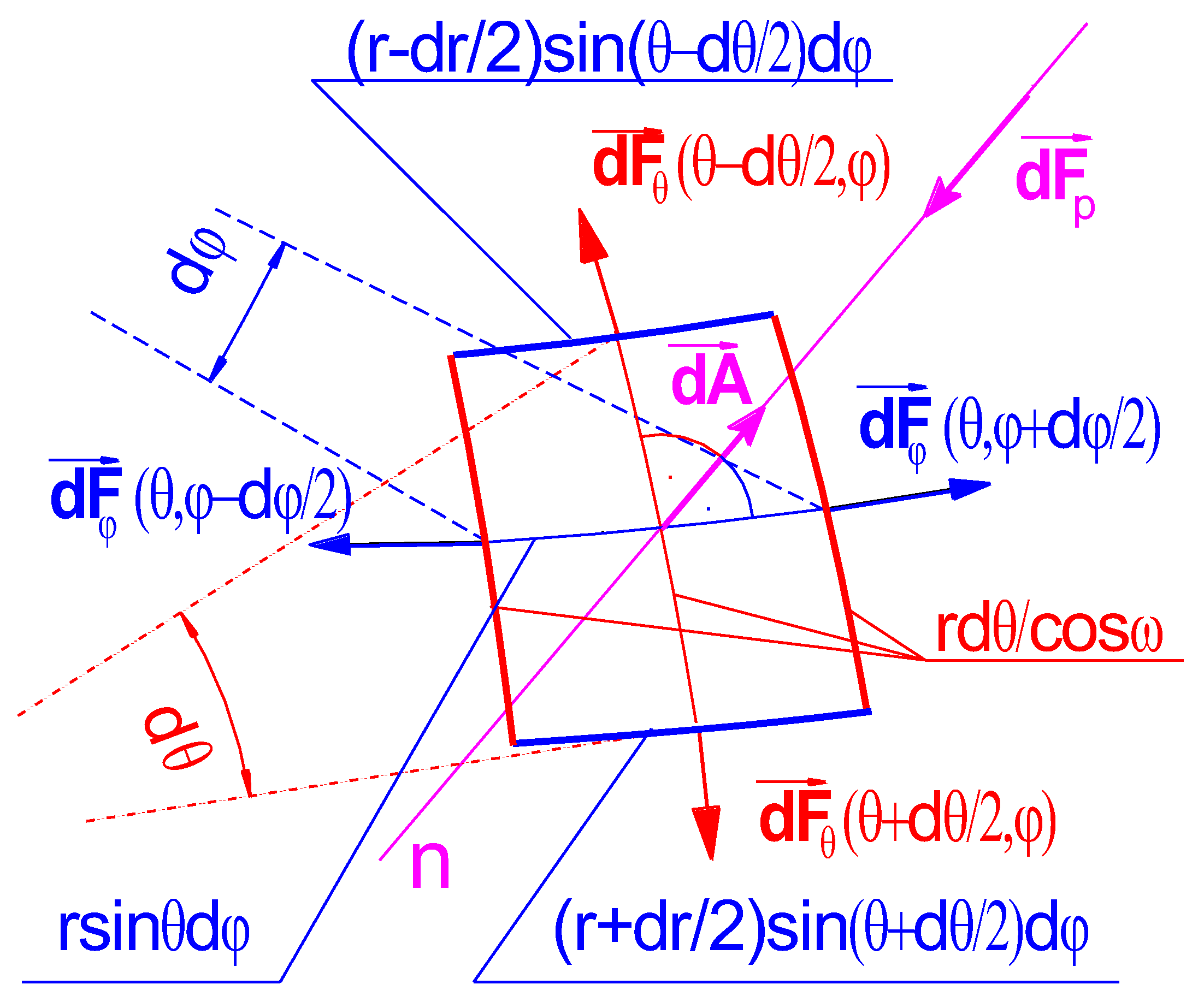
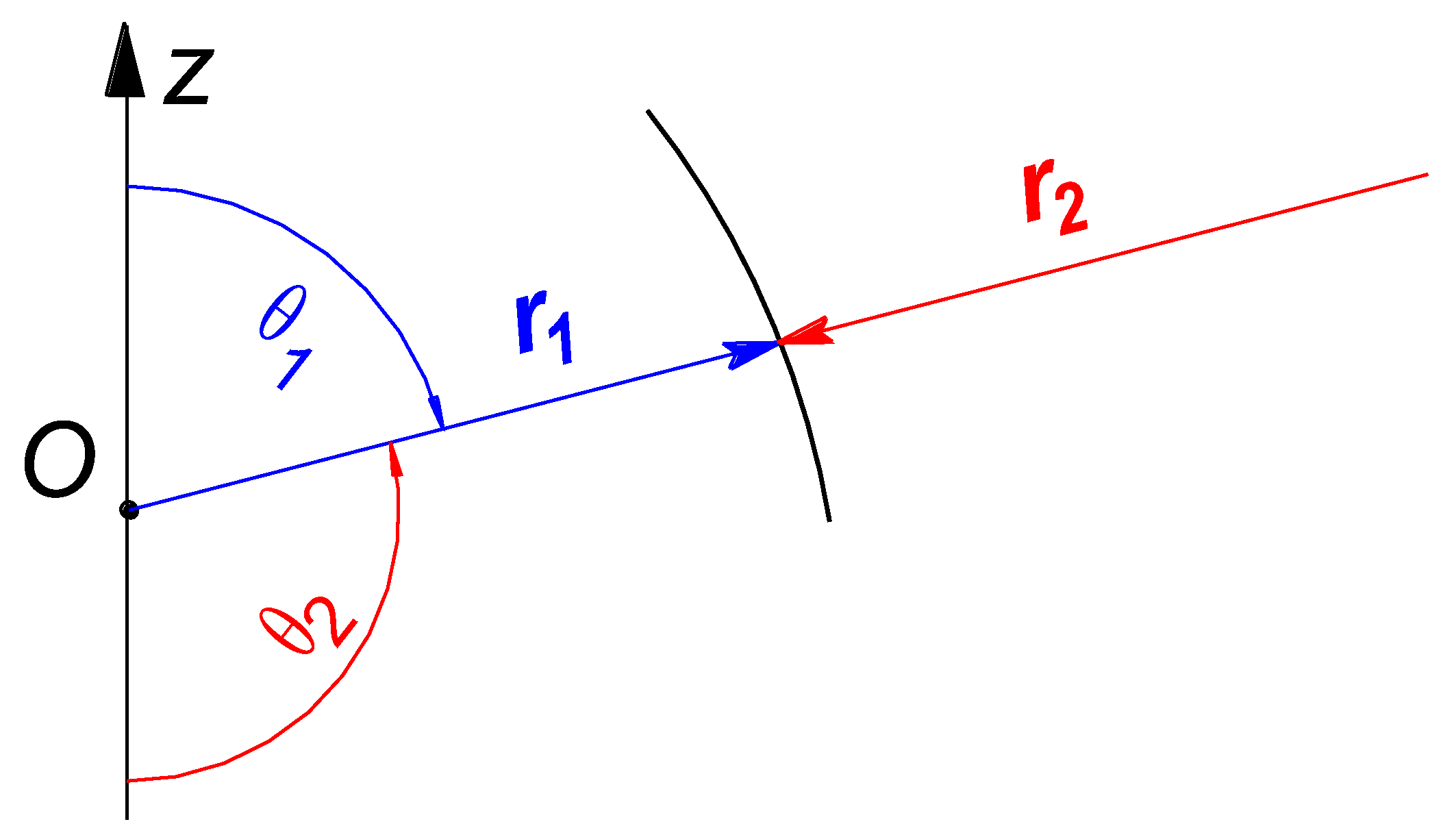
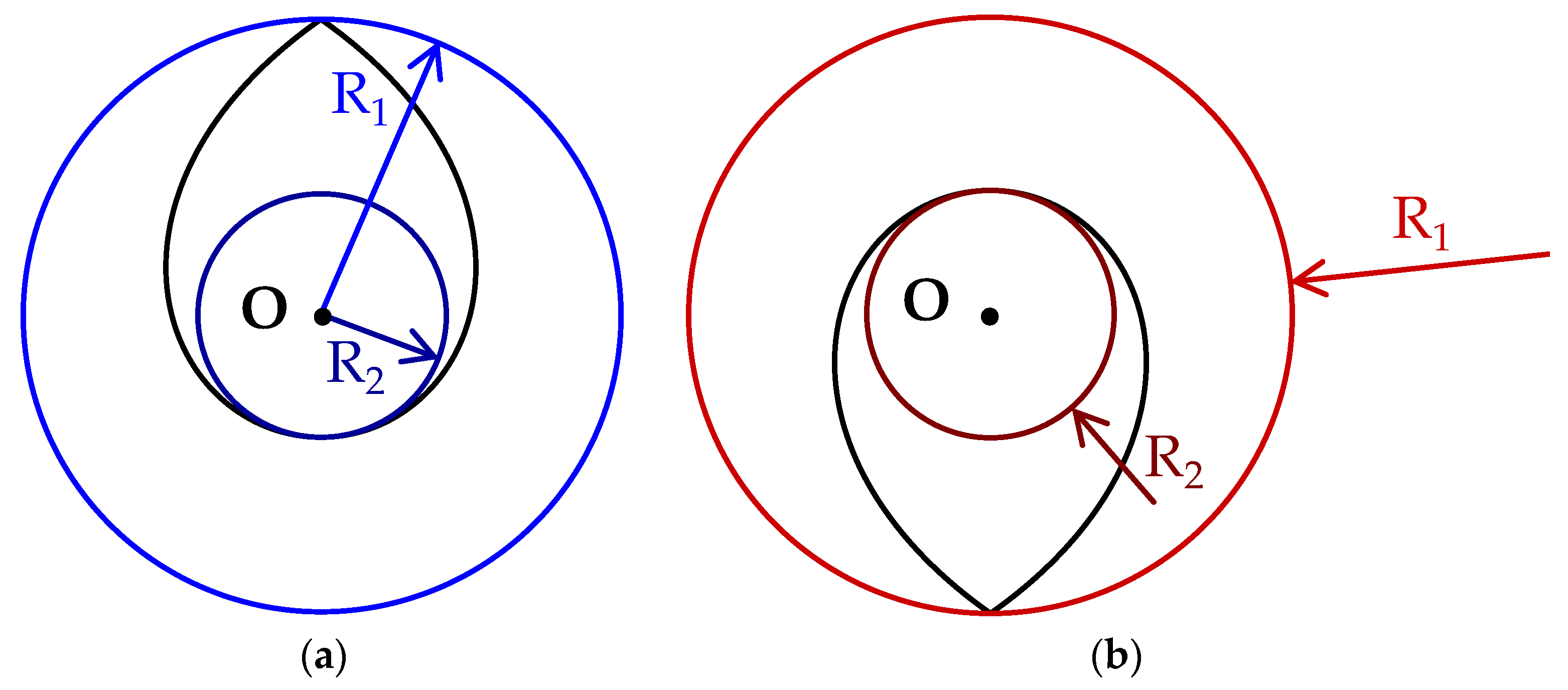

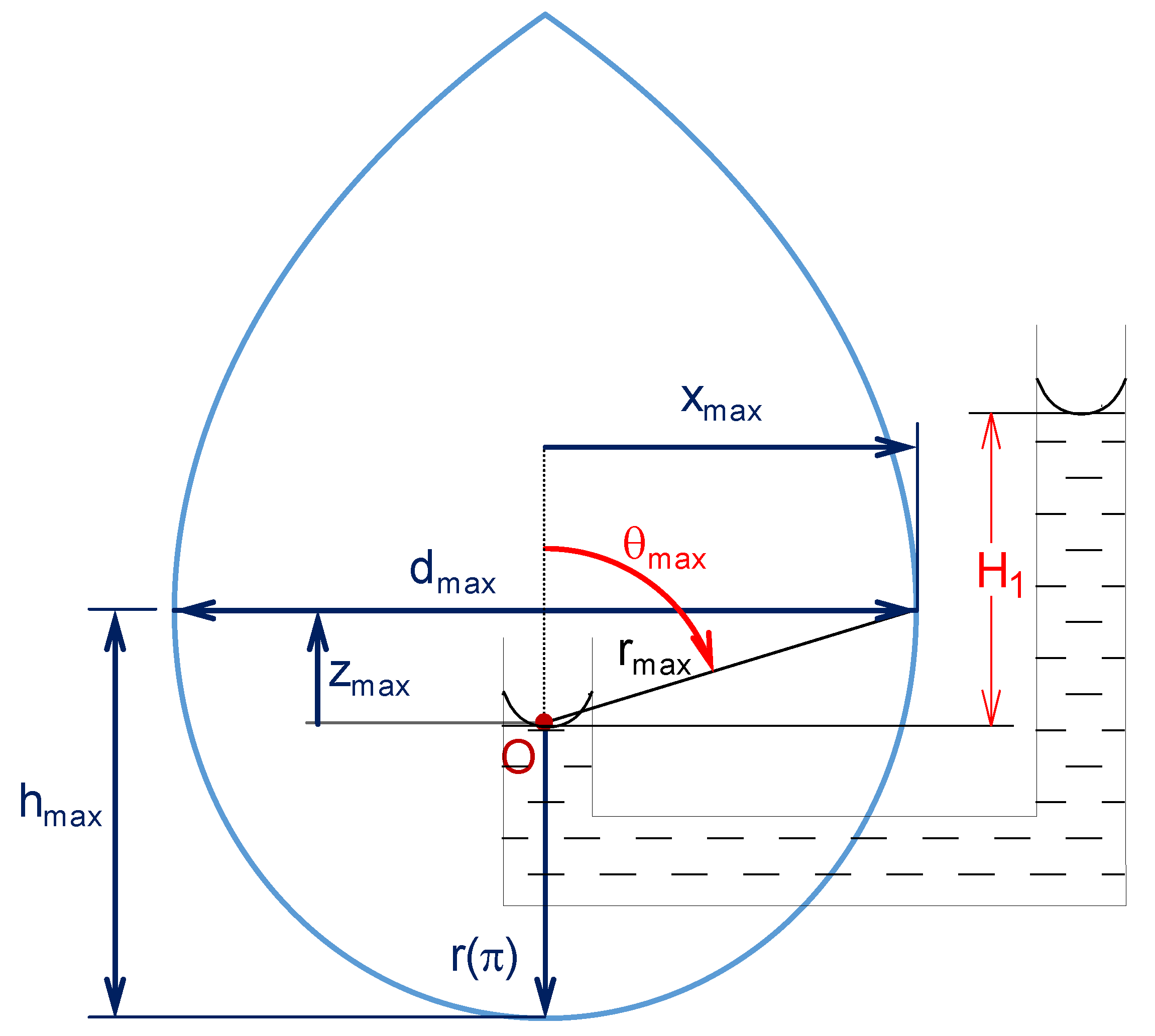
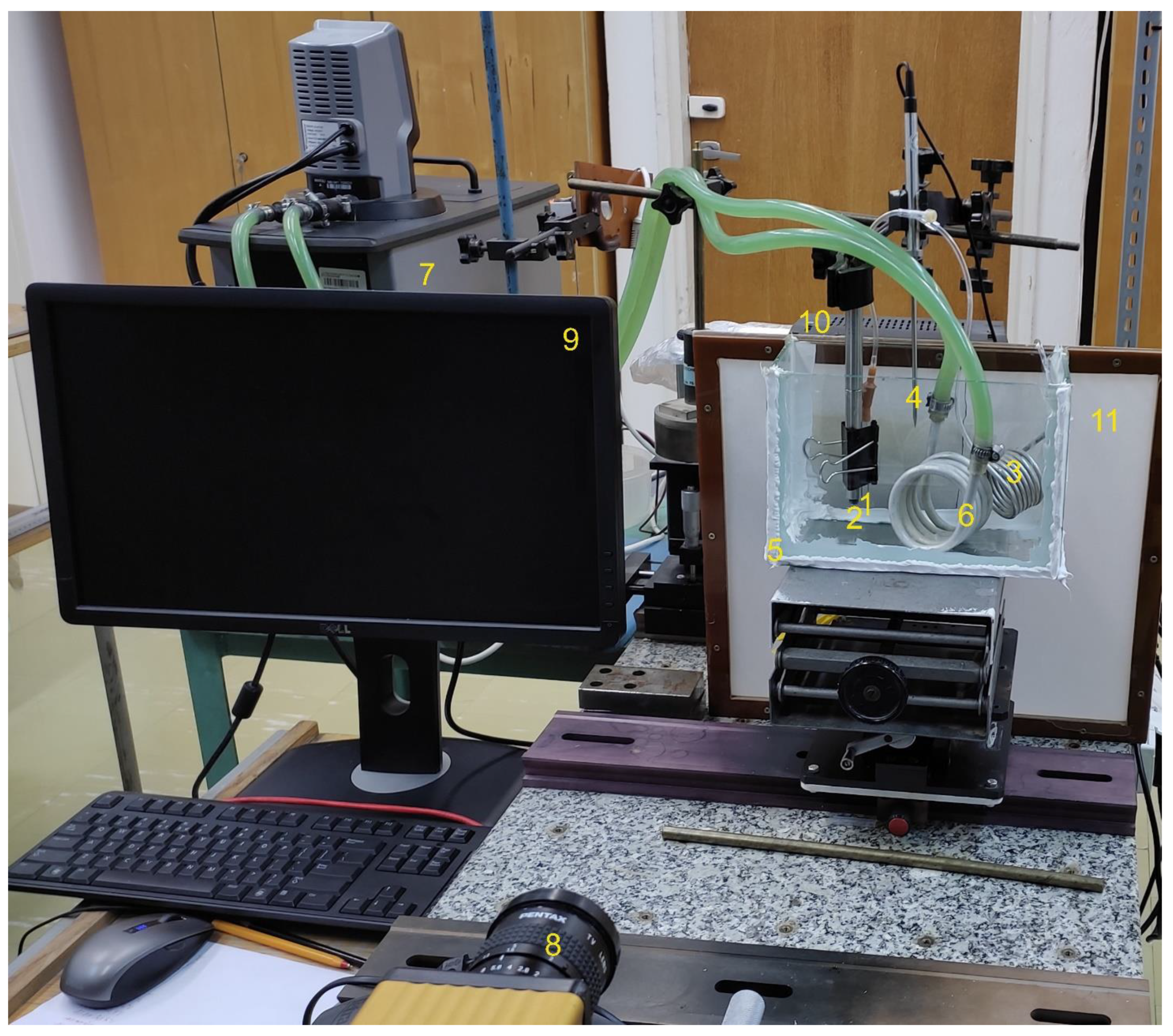

| Lp. | T | g | Equation (49) |
|---|---|---|---|
| - | [°C] | [N/m] | - |
| 1 | 2.2 | 0.053198 | −0.000049 |
| 2 | 2.7 | 0.05281 | −0.000072 |
| 3 | 4.9 | 0.052871 | 0.008169 |
| 4 | 9.8 | 0.052291 | 0.000670 |
| 5 | 20 | 0.051852 | 0.000246 |
| 6 | 20.5 | 0.050945 | −0.000763 |
| 7 | 20.8 | 0.051838 | 0.000149 |
| 8 | 24.9 | 0.050735 | 0.000231 |
| 9 | 25 | 0.050212 | 0.001298 |
| 10 | 29.7 | 0.050015 | 0.000003 |
| 11 | 30.5 | 0.051458 | 0.000178 |
| 12 | 40.3 | 0.049252 | 0.000088 |
| 13 | 40.9 | 0.04944 | 0.000119 |
| 14 | 50 | 0.048893 | 0.000040 |
| 15 | 51.4 | 0.049131 | 0.000045 |
| 16 | 60 | 0.049071 | 0.000015 |
| 17 | 60.4 | 0.049268 | 0.000058 |
| 18 | 70.9 | 0.047458 | −0.000134 |
| 19 | 72 | 0.047163 | 0.000391 |
| 20 | 80.7 | 0.047217 | 0.000053 |
| 21 | 90.6 | 0.046874 | −0.001967 |
| 22 | 96.4 | 0.042011 | −0.000003 |
| 23 | 97.8 | 0.033906 | 0.000068 |
| 24 | 98.9 | 0.027326 | 0.000383 |
Disclaimer/Publisher’s Note: The statements, opinions and data contained in all publications are solely those of the individual author(s) and contributor(s) and not of MDPI and/or the editor(s). MDPI and/or the editor(s) disclaim responsibility for any injury to people or property resulting from any ideas, methods, instructions or products referred to in the content. |
© 2023 by the authors. Licensee MDPI, Basel, Switzerland. This article is an open access article distributed under the terms and conditions of the Creative Commons Attribution (CC BY) license (https://creativecommons.org/licenses/by/4.0/).
Share and Cite
Gajewski, A.; Teleszewski, T.J. A New Method for Determining Interfacial Tension: Verification and Validation. Energies 2023, 16, 613. https://doi.org/10.3390/en16020613
Gajewski A, Teleszewski TJ. A New Method for Determining Interfacial Tension: Verification and Validation. Energies. 2023; 16(2):613. https://doi.org/10.3390/en16020613
Chicago/Turabian StyleGajewski, Andrzej, and Tomasz Janusz Teleszewski. 2023. "A New Method for Determining Interfacial Tension: Verification and Validation" Energies 16, no. 2: 613. https://doi.org/10.3390/en16020613
APA StyleGajewski, A., & Teleszewski, T. J. (2023). A New Method for Determining Interfacial Tension: Verification and Validation. Energies, 16(2), 613. https://doi.org/10.3390/en16020613







